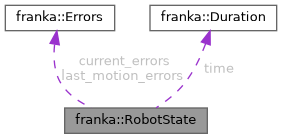 |
libfranka 0.15.0
FCI C++ API
|
 |
libfranka 0.15.0
FCI C++ API
|
Describes the robot state. More...
#include <robot_state.h>

Public Attributes | |
| std::array< double, 16 > | O_T_EE {} |
| \(^{O}T_{EE}\) Measured end effector pose in base frame. | |
| std::array< double, 16 > | O_T_EE_d {} |
| \({^OT_{EE}}_{d}\) Last desired end effector pose of motion generation in base frame. | |
| std::array< double, 16 > | F_T_EE {} |
| \(^{F}T_{EE}\) End effector frame pose in flange frame. | |
| std::array< double, 16 > | F_T_NE {} |
| \(^{F}T_{NE}\) Nominal end effector frame pose in flange frame. | |
| std::array< double, 16 > | NE_T_EE {} |
| \(^{NE}T_{EE}\) End effector frame pose in nominal end effector frame. | |
| std::array< double, 16 > | EE_T_K {} |
| \(^{EE}T_{K}\) Stiffness frame pose in end effector frame. | |
| double | m_ee {} |
| \(m_{EE}\) Configured mass of the end effector. | |
| std::array< double, 9 > | I_ee {} |
| \(I_{EE}\) Configured rotational inertia matrix of the end effector load with respect to center of mass. | |
| std::array< double, 3 > | F_x_Cee {} |
| \(^{F}x_{C_{EE}}\) Configured center of mass of the end effector load with respect to flange frame. | |
| double | m_load {} |
| \(m_{load}\) Configured mass of the external load. | |
| std::array< double, 9 > | I_load {} |
| \(I_{load}\) Configured rotational inertia matrix of the external load with respect to center of mass. | |
| std::array< double, 3 > | F_x_Cload {} |
| \(^{F}x_{C_{load}}\) Configured center of mass of the external load with respect to flange frame. | |
| double | m_total {} |
| \(m_{total}\) Sum of the mass of the end effector and the external load. | |
| std::array< double, 9 > | I_total {} |
| \(I_{total}\) Combined rotational inertia matrix of the end effector load and the external load with respect to the center of mass. | |
| std::array< double, 3 > | F_x_Ctotal {} |
| \(^{F}x_{C_{total}}\) Combined center of mass of the end effector load and the external load with respect to flange frame. | |
| std::array< double, 2 > | elbow {} |
| Elbow configuration. | |
| std::array< double, 2 > | elbow_d {} |
| Desired elbow configuration. | |
| std::array< double, 2 > | elbow_c {} |
| Commanded elbow configuration. | |
| std::array< double, 2 > | delbow_c {} |
| Commanded elbow velocity. | |
| std::array< double, 2 > | ddelbow_c {} |
| Commanded elbow acceleration. | |
| std::array< double, 7 > | tau_J {} |
| \(\tau_{J}\) Measured link-side joint torque sensor signals. | |
| std::array< double, 7 > | tau_J_d {} |
| \({\tau_J}_d\) Desired link-side joint torque sensor signals without gravity. | |
| std::array< double, 7 > | dtau_J {} |
| \(\dot{\tau_{J}}\) Derivative of measured link-side joint torque sensor signals. | |
| std::array< double, 7 > | q {} |
| \(q\) Measured joint position. | |
| std::array< double, 7 > | q_d {} |
| \(q_d\) Desired joint position. | |
| std::array< double, 7 > | dq {} |
| \(\dot{q}\) Measured joint velocity. | |
| std::array< double, 7 > | dq_d {} |
| \(\dot{q}_d\) Desired joint velocity. | |
| std::array< double, 7 > | ddq_d {} |
| \(\ddot{q}_d\) Desired joint acceleration. | |
| std::array< double, 7 > | joint_contact {} |
| Indicates which contact level is activated in which joint. | |
| std::array< double, 6 > | cartesian_contact {} |
| Indicates which contact level is activated in which Cartesian dimension \((x,y,z,R,P,Y)\). | |
| std::array< double, 7 > | joint_collision {} |
| Indicates which contact level is activated in which joint. | |
| std::array< double, 6 > | cartesian_collision {} |
| Indicates which contact level is activated in which Cartesian dimension \((x,y,z,R,P,Y)\). | |
| std::array< double, 7 > | tau_ext_hat_filtered {} |
| \(\hat{\tau}_{\text{ext}}\) Low-pass filtered torques generated by external forces on the joints. | |
| std::array< double, 6 > | O_F_ext_hat_K {} |
| \(^OF_{K,\text{ext}}\) Estimated external wrench (force, torque) acting on stiffness frame, expressed relative to the base frame. | |
| std::array< double, 6 > | K_F_ext_hat_K {} |
| \(^{K}F_{K,\text{ext}}\) Estimated external wrench (force, torque) acting on stiffness frame, expressed relative to the stiffness frame. | |
| std::array< double, 6 > | O_dP_EE_d {} |
| \({^OdP_{EE}}_{d}\) Desired end effector twist in base frame. | |
| std::array< double, 3 > | O_ddP_O {} |
| \({^OddP}_O\) Linear component of the acceleration of the robot's base, expressed in frame parallel to the base frame, i.e. | |
| std::array< double, 16 > | O_T_EE_c {} |
| \({^OT_{EE}}_{c}\) Last commanded end effector pose of motion generation in base frame. | |
| std::array< double, 6 > | O_dP_EE_c {} |
| \({^OdP_{EE}}_{c}\) Last commanded end effector twist in base frame. | |
| std::array< double, 6 > | O_ddP_EE_c {} |
| \({^OddP_{EE}}_{c}\) Last commanded end effector acceleration in base frame. | |
| std::array< double, 7 > | theta {} |
| \(\theta\) Motor position. | |
| std::array< double, 7 > | dtheta {} |
| \(\dot{\theta}\) Motor velocity. | |
| Errors | current_errors {} |
| Current error state. | |
| Errors | last_motion_errors {} |
| Contains the errors that aborted the previous motion. | |
| double | control_command_success_rate {} |
| Percentage of the last 100 control commands that were successfully received by the robot. | |
| RobotMode | robot_mode = RobotMode::kUserStopped |
| Current robot mode. | |
| Duration | time {} |
| Strictly monotonically increasing timestamp since robot start. | |
Describes the robot state.
| std::array<double, 6> franka::RobotState::cartesian_collision {} |
Indicates which contact level is activated in which Cartesian dimension \((x,y,z,R,P,Y)\).
After contact disappears, the value stays the same until a reset command is sent.
| std::array<double, 6> franka::RobotState::cartesian_contact {} |
Indicates which contact level is activated in which Cartesian dimension \((x,y,z,R,P,Y)\).
After contact disappears, the value turns to zero.
| double franka::RobotState::control_command_success_rate {} |
Percentage of the last 100 control commands that were successfully received by the robot.
Shows a value of zero if no control or motion generator loop is currently running.
Range: \([0, 1]\).
| std::array<double, 2> franka::RobotState::ddelbow_c {} |
Commanded elbow acceleration.
The values of the array are:
| std::array<double, 7> franka::RobotState::ddq_d {} |
\(\ddot{q}_d\) Desired joint acceleration.
Unit: \([\frac{rad}{s^2}]\)
| std::array<double, 2> franka::RobotState::delbow_c {} |
Commanded elbow velocity.
The values of the array are:
| std::array<double, 7> franka::RobotState::dq {} |
\(\dot{q}\) Measured joint velocity.
Unit: \([\frac{rad}{s}]\)
| std::array<double, 7> franka::RobotState::dq_d {} |
\(\dot{q}_d\) Desired joint velocity.
Unit: \([\frac{rad}{s}]\)
| std::array<double, 7> franka::RobotState::dtau_J {} |
\(\dot{\tau_{J}}\) Derivative of measured link-side joint torque sensor signals.
Unit: \([\frac{Nm}{s}]\)
| std::array<double, 7> franka::RobotState::dtheta {} |
\(\dot{\theta}\) Motor velocity.
Unit: \([\frac{rad}{s}]\)
| std::array<double, 16> franka::RobotState::EE_T_K {} |
\(^{EE}T_{K}\) Stiffness frame pose in end effector frame.
Pose is represented as a 4x4 matrix in column-major format.
See also K frame.
| std::array<double, 2> franka::RobotState::elbow {} |
Elbow configuration.
The values of the array are:
| std::array<double, 2> franka::RobotState::elbow_c {} |
Commanded elbow configuration.
The values of the array are:
| std::array<double, 2> franka::RobotState::elbow_d {} |
Desired elbow configuration.
The values of the array are:
| std::array<double, 16> franka::RobotState::F_T_EE {} |
| std::array<double, 16> franka::RobotState::F_T_NE {} |
| std::array<double, 7> franka::RobotState::joint_collision {} |
Indicates which contact level is activated in which joint.
After contact disappears, the value stays the same until a reset command is sent.
| std::array<double, 7> franka::RobotState::joint_contact {} |
Indicates which contact level is activated in which joint.
After contact disappears, value turns to zero.
| std::array<double, 6> franka::RobotState::K_F_ext_hat_K {} |
\(^{K}F_{K,\text{ext}}\) Estimated external wrench (force, torque) acting on stiffness frame, expressed relative to the stiffness frame.
Forces applied by the robot to the environment are positive, while forces applied by the environment on the robot are negative. Becomes \([0,0,0,0,0,0]\) when near or in a singularity. See also Stiffness frame K. Unit: \([N,N,N,Nm,Nm,Nm]\).
| std::array<double, 16> franka::RobotState::NE_T_EE {} |
\(^{NE}T_{EE}\) End effector frame pose in nominal end effector frame.
Pose is represented as a 4x4 matrix in column-major format.
| std::array<double, 6> franka::RobotState::O_ddP_EE_c {} |
\({^OddP_{EE}}_{c}\) Last commanded end effector acceleration in base frame.
Unit: \([\frac{m}{s^2},\frac{m}{s^2},\frac{m}{s^2},\frac{rad}{s^2},\frac{rad}{s^2},\frac{rad}{s^2}]\).
| std::array<double, 3> franka::RobotState::O_ddP_O {} |
\({^OddP}_O\) Linear component of the acceleration of the robot's base, expressed in frame parallel to the base frame, i.e.
the base's translational acceleration. If the base is resting this shows the direction of the gravity vector. It is harcoded for now to {0, 0, -9.81}.
| std::array<double, 6> franka::RobotState::O_dP_EE_c {} |
\({^OdP_{EE}}_{c}\) Last commanded end effector twist in base frame.
Unit: \([\frac{m}{s},\frac{m}{s},\frac{m}{s},\frac{rad}{s},\frac{rad}{s},\frac{rad}{s}]\).
| std::array<double, 6> franka::RobotState::O_dP_EE_d {} |
\({^OdP_{EE}}_{d}\) Desired end effector twist in base frame.
Unit: \([\frac{m}{s},\frac{m}{s},\frac{m}{s},\frac{rad}{s},\frac{rad}{s},\frac{rad}{s}]\).
| std::array<double, 6> franka::RobotState::O_F_ext_hat_K {} |
\(^OF_{K,\text{ext}}\) Estimated external wrench (force, torque) acting on stiffness frame, expressed relative to the base frame.
Forces applied by the robot to the environment are positive, while forces applied by the environment on the robot are negative. Becomes \([0,0,0,0,0,0]\) when near or in a singularity. See also Stiffness frame K. Unit: \([N,N,N,Nm,Nm,Nm]\).
| std::array<double, 16> franka::RobotState::O_T_EE {} |
\(^{O}T_{EE}\) Measured end effector pose in base frame.
Pose is represented as a 4x4 matrix in column-major format.
| std::array<double, 16> franka::RobotState::O_T_EE_c {} |
\({^OT_{EE}}_{c}\) Last commanded end effector pose of motion generation in base frame.
Pose is represented as a 4x4 matrix in column-major format.
| std::array<double, 16> franka::RobotState::O_T_EE_d {} |
\({^OT_{EE}}_{d}\) Last desired end effector pose of motion generation in base frame.
Pose is represented as a 4x4 matrix in column-major format.
| std::array<double, 7> franka::RobotState::q {} |
\(q\) Measured joint position.
Unit: \([rad]\)
| std::array<double, 7> franka::RobotState::q_d {} |
\(q_d\) Desired joint position.
Unit: \([rad]\)
| std::array<double, 7> franka::RobotState::tau_ext_hat_filtered {} |
\(\hat{\tau}_{\text{ext}}\) Low-pass filtered torques generated by external forces on the joints.
It does not include configured end-effector and load nor the mass and dynamics of the robot. tau_ext_hat_filtered is the error between tau_J and the expected torques given by the robot model. Unit: \([Nm]\).
| std::array<double, 7> franka::RobotState::tau_J {} |
\(\tau_{J}\) Measured link-side joint torque sensor signals.
Unit: \([Nm]\)
| std::array<double, 7> franka::RobotState::tau_J_d {} |
\({\tau_J}_d\) Desired link-side joint torque sensor signals without gravity.
Unit: \([Nm]\)
| std::array<double, 7> franka::RobotState::theta {} |
\(\theta\) Motor position.
Unit: \([rad]\)
| Duration franka::RobotState::time {} |
Strictly monotonically increasing timestamp since robot start.
Inside of control loops time_step parameter of Robot::control can be used instead.